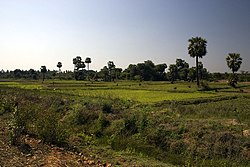
The Northern Circars was a division of British India's Madras Presidency. It consisted of a narrow slip of territory lying along the western side of the Bay of Bengal from 15° 40′ to 20° 17′ north latitude, in the present-day Indian states of Andhra Pradesh and Odisha. The Subah of Deccan (Hyderabad/Golconda) consisted of 22 circars. These northern circars were five in number and the most prominent ones in the Subah.

Rayagada district is a district in southern Odisha, a state in India, which became a separate district in October 1992. Its population consists mainly of tribes, primarily the Khonds and the Soras. In addition to Odia, Kui and Sora are spoken by the district's indigenous population. It was founded by Maharajah Biswanatha Deba Gajapati of the Surjyabansha dynasty of Jeypore.

Jeypore is one of the largest towns and a place of historical significance in Koraput district in the Indian state of Odisha. It was established by Vir Vikram Dev in the mid 17th century. The kingdom was defeated by the East India Company in 1777 who declared it a Zamindari or Feudatory of the British Crown and much later got acknowledged as a Princely state until its dissolution in the Dominion of India in 1947.
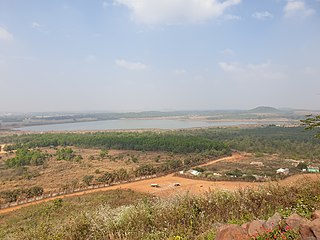
Nabarangpur district, also known as Nabarangapur district or Nawarangpur district, is a district of Odisha, India. The city of Nabarangpur is the district capital. Most of its population is tribal and the land is heavily forested. It borders Kalahandi and Koraput districts. Nabarangpur district is situated at 19.14′ latitude and 82.32′ longitude at an average elevation of 572 metres (1,877 ft).
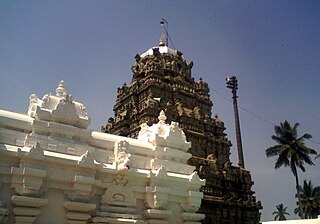
Sri Kurmam also known as Srikurmu or Srikurmais a village near Srikakulam, Andhra Pradesh, India. Srikurmam village is situated at a distance of 14.5 km to the South-east of Srikakulam town. It is in the Gara mandal of Srikakulam district. The village was named after the Srikurmam temple dedicated to Kurma avatar of the Hindu god Vishnu, which was re-established by Eastern Ganga Dynasty King Anantavarman Chodaganga Deva.
The Gajapati Empire, was an empire established by the Suryavamsa dynasty or Routray dynasty, who were a medieval Hindu dynasty in the Indian subcontinent. It originated in the region of Trikalinga and reigned from 1434 to 1541 CE. It succeeded the reign of the Eastern Gangas. Under the Emperor Kapilendra Deva, the Gajapati empire stretched from lower Ganga in the north to Kaveri in the south.

North Andhra or Uttara Andhra, also known as Kalinga Andhra, is a geographic region in the Indian state of Andhra Pradesh. It is between the Eastern Ghats and the coast of the Bay of Bengal. It comprises six northern districts of the state, Srikakulam, Parvathipuram Manyam, Vizianagaram, Visakhapatnam, Alluri Sitharama Raju and Anakapalli. As of 2011 census of India, the region with six districts has a population of 9,338,177.

The recorded history of Andhra Pradesh, one of the 28 states of 21st-century India, begins in the Vedic period. It is mentioned in Sanskrit epics such as the Aitareya Brahmana. Its sixth-century BCE incarnation Assaka lay between the Godavari and Krishna Rivers, one of sixteen mahajanapadas. The Satavahanas succeeded them, built Amaravati, and reached a zenith under Gautamiputra Satakarni.
Sir Pusapati Ananda Gajapati RajuGCIE was the 10th Maharaja of Vizianagaram.

The Eastern Ganga dynasty were a large medieval era Indian royal Hindu dynasty that reigned from Kalinga from as early as the 5th century to the mid 20th century. Eastern Gangas ruled much of the modern region of Odisha in three different phases by the passage of time, known as Early Eastern Gangas (493–1077), Imperial Eastern Gangas (1077–1436) and Khemundi Gangas (1436–1947). They are known as "Eastern Gangas" to distinguish them from the Western Gangas who ruled over Karnataka. The territory ruled by the dynasty consisted of the whole of the modern-day Indian state of Odisha, as well as major parts of north Andhra Pradesh, parts of Chhattisgarh and some southern districts of West Bengal. Odia language got official status in their regime following the evolution of the language from Odra Prakrit. The early rulers of the dynasty ruled from Dantapuram; the capital was later moved to Kalinganagara, and ultimately to Kataka and then to Paralakhemundi.
Poosapati / Pusapati was the ruling clan of the Northern Andhra region, Vizianagaram.
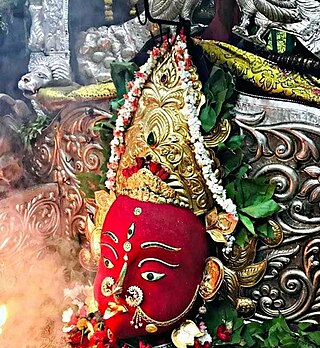
Majhighariani Temple is a shrine to a goddess in the Rayagada township of Odisha. It was built by King Vishwanath Dev Gajapati of the Suryavansh dynasty of Nandapur - Jeypore kingdom. It is believed that he made Rayagada his capital and after the construction of the temple he went on to conquer a vast dominion and expanded his kingdom from parts of Bengal to Telangana in south.
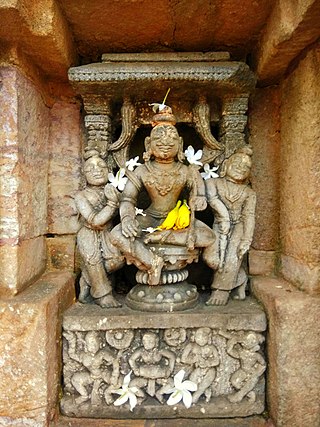
Kapilendra Deva was the founder of the Suryavamsa Gajapati Empire that ruled parts of eastern and southern India with the present-day Odisha as the center of the empire. He ascended to the throne after staging a military coup against the preceding and the last ruler from the Eastern Ganga dynasty, Bhanu Deva IV. He is also referred to as Kapilendra Routray or Sri Sri Kapilendra Deva. Kapilendra claimed descent from the Surya Vamsha of the Mahābhārata and was conferred the regnal title Shri Shri ...(108 times) Gajapati Gaudeshwara NabaKoti Karnata Kalabargeswara i.e. the Lord of Bengal (Gauda), the lord of the Karnataka region or Vijayanagara, the Lord of Kalaburagi and of nine crore subjects.
Biswanathpur is a village in Ganjam district in the south of Odisha, India, bordering Andhra Pradesh. This village owes its name to Vishwanath Dev Gajapati, the Suryavanshi king of Kalinga who founded this place after conducting a royal anicent ritual known as 'Vajapeya Yagna'. It is located southeast of Berhampur and northeast of Ichchapuram.
Jagannatha Gajapati Narayana Deo II was the Odia monarch of the Paralakhemundi Estate in the southern part of today's Odisha and northern Andhra Pradesh. He was from the Eastern Ganga dynasty of the Khemundi Ganga Branch from the year 1736 CE to 1771 CE. He had ascended to the throne at the age of eighteen and at a time when Odisha was torn apart due conflicts between external powers like the Mughals, Marathas, French and British for control of the territory. He invaded khurdha Bhoi dynasty king Birakishore Deva and Vizianagaram estate King Pusapati Vijayarama Raju II and defeated the both kings. He made the last great attempts on his own to revive the lost glory of Odisha and its unique Hindu culture that revolved around the tradition of Jagannath worship. He had defied the authority of the Nizam of Hyderabad and maintained his own sovereignty. He was one of the first rulers who indulged in conflicts with the new European colonists in the eastern part of India. He was also effort bound till the end of his life in framing strategic diplomatic plans to free the ancient land of Odisha from external aggressors and revival of its lost Eastern Ganga Dynasty-Gajapati glory from the past.

Maharajah Vikram Dev IV or Vikram Deo Varma was the 25th king of the Suryavansh dynasty that ruled over Kalinga and later Jeypore Samasthanam under the British. A patron of the arts and literature, he was also a writer and a proficient playwright. He was also an administrator, a magistrate for Visakhapatnam by the Madras government in 1914 and involved in the delineation of the state of Odisha.
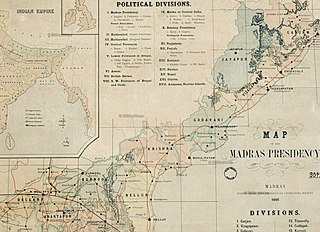
Jeypore Estate or Jeypore Zamindari was a Zamindari estate of the Madras Presidency in British India. Historically it was a kingdom known as Jeypore Kingdom, located in the highlands of the western interiors of the Kalinga region that existed from the mid-15th century to 1777 CE. It was earlier a tributary state of the Gajapati Empire and following its decline in 1540, it gained sovereignty and later became a tributary state of the Qutb Shahis until 1671. The kingdom regained degrees of semi-independence until it became a vassal state of the British in 1777. It eventually formed a part of the linguistic Orissa Province in 1936 upon transfer from the Madras Province and became a part of the independent Union of India in 1947.
Vishwanath Dev Gajapati was the king of Kalinga who established a kingdom in the region of Odisha and Andhra Pradesh, historically known as Kalinga. He belonged to the Shankara dynasty that was installed in the region by his great-grandfather Vinayaka Dev and his wife Lilavati. The Silavamsa king Pratap Ganga Raja died without any male heir, only leaving behind his wife and daughter Lilavati. Vinayak Dev who migrated from Jammu or Kashmir after praying to Kashi Vishwanath married Lilavati. Accordingly, the dynasty was called Shankara dynasty. Vinayak Dev also claimed to belong to the legendary Solar dynasty or Suryavansh.
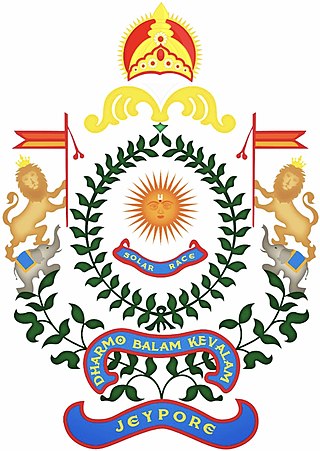
Maharaja of Jeypore was the principal title used by the rulers of the Kingdom of Jeypore until its dissolution in 1947. It was also used by the titular rulers until the removal of titles and privileges of all princely states and estates by the 26th amendment of the Constitution of India. However, due to the significance given to the traditional and religious role of a king, evidently, Vishweshwar Dev in 2013 became the Maharaja of Jeypore in pretense.
